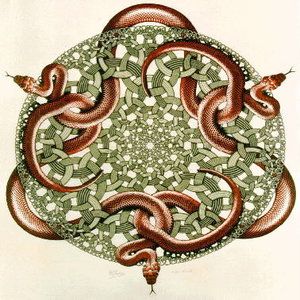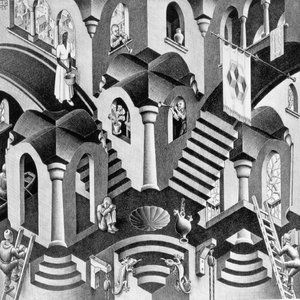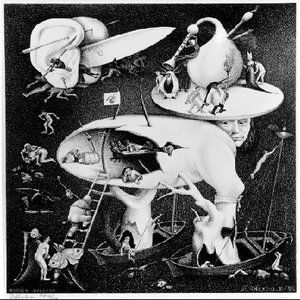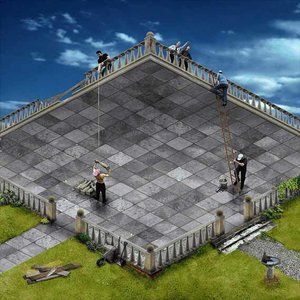Maurits Cornelis Escher was a Dutch graphic artist who became famous for his typically mathematically influenced woodcuts, lithographs, as well as mezzotints.
M.C Escher was born on June 17, 1898 in Leeuwarden, Netherlands. Moreover, he passed away on March 27, 1972. He is actually among the world's most popular graphic artists. His artworks are appreciated by lots of people around the globe.
He is certainly best known for his supposed impossible constructions, for example Ascending and Descending, Relativity and his Transformation Prints, which includes Metamorphosis I, Metamorphosis II, Metamorphosis III, Sky & Water I and Reptiles.
Earlier in his life, M.C Escher sketched landscapes as well as natural scenery. He in addition sketched insects, which showed up regularly in his future artworks. His initial creative work, accomplished in 1922, included 8 human beings heads separated in unique planes. Eventually around 1924, he had diminished desire for "regular division" of planes, and thus explored sketching countryside in Italy with unusual outlook which were unachievable in all-natural shape.

In 1937, M.C Escher's very first printing of an impossible reality was “Still Life and Street” furthermore his unusual sketches were made from imagery of in his mind, instead of straight from findings as well as trips to some overseas places. A prominent samples of his artwork was “Drawing Hands”, a work in which 2 hands are presented , each one sketching the other; also “Sky and Water”, where light takes on shadow to morph the water back-ground behind fish shapes into bird forms on a skies back-ground; also “Descending and Ascending” , just like traces of persons descend and ascend stairways in a limitless loop, on a construction work that may be difficult to construct but only likely to be sketched by engaging quirks of insight as well as perception.
He worked well mostly by means of lithographs in addition to woodcuts, however, some mezzotints he created are known to be masterpieces of a kind too. In his graphic artwork, he displayed mathematical connections among shapes, figures and also space. Furthermore, he tried using interlocking shapes with black and white colors to enrich individual dimensions. Included into his prints were mirror graphics of cones, cubes, spheres, rings as well as spirals.
While M. C Escher did not actually possess mathematical training but, his knowledge about mathematics was essentially visual and also intrinsic. His artwork had a substantial mathematical feature, even more than many of the worlds that he drew were designed around unattainable aspects just like, the “Penrose triangle” and also the “Penrose stairways”. The majority of Escher's works utilized repetitive tilings generally known as tessellations. His designs are particularly appreciated by mathematicians together with scientists, who delight in his application of polyhedral as well as geometric distortions. Take for instance, in Gravity, multi-colored turtles poke their heads outside of a stellated dodecahedron.
The mathematical impact in his work came about around 1936, while he traveled to the Mediterranean with the Adria Freight Company. He started to be excited about symmetry and order. Escher stated that his trip by way of the Mediterranean was the "the richest source of motivation I have ever tapped.”

After his trip to the Alhambra, Escher endeavored to enhance upon the Moors by utilizing geometric grids being the foundation for his drawings, which he subsequently overlaid with extra layout, mostly with animal species like birds together with lions.
However, his very first learning of mathematics, which afterwards resulted in integration of mathematics into his artworks, started with George Pólya's scholarly paper on plane symmetry groups was made available to him by his brother Berend. This document influenced him to study the ideas about the seventeen wallpaper groups (plane symmetry groups). By applying the mathematical principle, Escher designed regular tilings with 43 colored illustrations of various kinds of symmetry. With this he established a mathematical strategy to drawing of symmetry in his works of art. From 1937, he made woodcuts applying the concept of the seventeen plane symmetry sects.

In 1941, Escher summarized his discoveries in a sketchbook, which he classified as Regelmatige vlakverdeling in asymmetrische congruente veelhoeken meaning - "Regular division of the plane with asymmetric congruent polygons". The objective for writing the book was to help him in incorporating mathematics into his artwork. M.C Escher was also regarded as a research mathematician of his days on account of his paperwork, whereby he researched color based division, in addition to developing a method of categorizing patterns of shape, color and also symmetrical elements.
In 1956, Escher utilized the concept of signifying infinity on a two-dimensional plane. However, his conversations with a Canadian mathematician H.S.M. Coxeter influenced Escher's attraction for hyperbolic tessellations that are typical tilings of the hyperbolic plane. Escher's wooden engravings Circle Limit I to IV illustrate this principle. Also in 1959, Coxeter circulated his finding that all these artworks were extremely consistent: "Escher really got it correct to the millimeter."
Moreover, Escher was honored with award of Knighthood of the Order of Orange Nassau in 1955. Thereupon he frequently created artworks for dignitaries globally.


Please complete your information below to login.
Sign In
Create New Account